| Alfredo Andersen Museum - MAP 7 The historical importance for Paraná of the Norwegian artist Alfredo Andersen (1860-1935), and which justifies the maintenance of a museum in his honor, lies in him being considered the first artist to act professionally and to encourage arts education in this pure state. Moreover, the quality of representation that his works present is in many ways superior to the other artists who were in Parana during that period. His in... |
| Capão da Imbuia Woods - MAP 7 This is actually a park, with a few varying attractions within the park. There is the Natural History Museum, the Capão da Imbuia Woods, the Capão da Imbuia Wood tree, and Path of the Araucaria.
The Natural History Museum highlights many of the fauna found within Brazil. It includes many more animals, and even local vegetables.
The Capão da Imbuia Woods is the actual park itself, and holds Capão da Imbuia ... |
| Curitiba Memorial - MAP 4
Memorial de Curitiba is a modern space designed to house multiple cultural activities, including exhibitions and musical and scenic, and preserve and expose the city's history. The space is also used for seminars, lectures, workshops, conferences, book launches, among other activities. Its facilities include showrooms.
Conceived in the 300 years of Curitiba, the Memorial was designed on modern lines, met... |
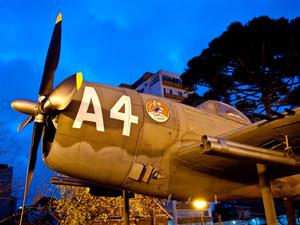 Expedicionario Museum - MAP 7 The Museu do Expedicionário constitutes today one of the most complete thematic museums in Brazil regarding the second world war, having in its collection a large quantity of documents, photographs, maps and illustrations.
In it are exposed to various kinds of war materials, such as uniforms, equipment, individual and collective, weapons, ammunition, and other objects that were used by the Brazilian Expeditionary Force (... Expedicionario Museum - MAP 7 The Museu do Expedicionário constitutes today one of the most complete thematic museums in Brazil regarding the second world war, having in its collection a large quantity of documents, photographs, maps and illustrations.
In it are exposed to various kinds of war materials, such as uniforms, equipment, individual and collective, weapons, ammunition, and other objects that were used by the Brazilian Expeditionary Force (... |
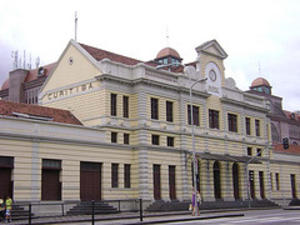 Ferroviário Museum - MAP 7 The Railroad Museum of Curitiba is situated in Curitiba's former train station, on the Avenida Sete de Setembro. Much of the old station has been fully restored, allowing visitors to actually see what the old rail road era was like and how it functioned. There are many displays, including numerous bells, rail road documents, historic and typical furnishings, original maps, old telephones and original train whistles. There are also ple... Ferroviário Museum - MAP 7 The Railroad Museum of Curitiba is situated in Curitiba's former train station, on the Avenida Sete de Setembro. Much of the old station has been fully restored, allowing visitors to actually see what the old rail road era was like and how it functioned. There are many displays, including numerous bells, rail road documents, historic and typical furnishings, original maps, old telephones and original train whistles. There are also ple... |
| Memorial da Imigração Polonesa - MAP 7
Located in the Bosque do Papa João Paulo II, a green area of 46,000 square meters, in the city center, the Polish Memorial is an outdoor museum. There are seven log houses built with the wood of local pine trees, typical of the materials that Polish immigrants used. The houses contain many items that the Polish used or built for their daily lives. Including furniture, and household items such as the sour cabbage barrel, where ... |
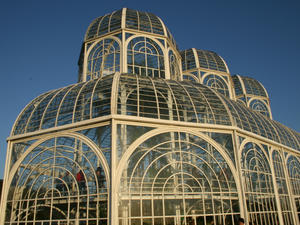 Museu Botânico de Curitiba - MAP 7 The Botanical Museum Hall in the Botanical Garden of Curitiba, has ample space for exhibitions, a library and auditorium. It has an herbarium of 310,000 plants, known worldwide, with the largest number of genera and families of plants in Brazil. It was created in 1965 from the donation of the personal collection of botanical researcher Gerdt Hatschbach. His first headquarters were on the Public Road. Only in 1992 the Museum was transfe... Museu Botânico de Curitiba - MAP 7 The Botanical Museum Hall in the Botanical Garden of Curitiba, has ample space for exhibitions, a library and auditorium. It has an herbarium of 310,000 plants, known worldwide, with the largest number of genera and families of plants in Brazil. It was created in 1965 from the donation of the personal collection of botanical researcher Gerdt Hatschbach. His first headquarters were on the Public Road. Only in 1992 the Museum was transfe... |
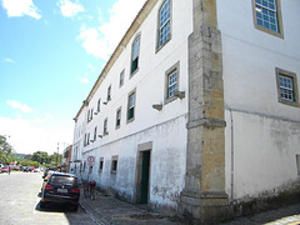 Museu de Arqueologia e Etnologia - MAP 7
The Museum of Archaeology and Ethnology at UFPR (MAE), was inaugurated in 1962 and is the first university museum in the state of Parana. The main office is located in the municipality of Paranaguá, in the premises of the building that housed the former Jesuit College, founded in 1755. The headquarters building of the museum was transferred to the custody of UFPR in 1958. In addition to this seat in Paranagua, it has its Techn... Museu de Arqueologia e Etnologia - MAP 7
The Museum of Archaeology and Ethnology at UFPR (MAE), was inaugurated in 1962 and is the first university museum in the state of Parana. The main office is located in the municipality of Paranaguá, in the premises of the building that housed the former Jesuit College, founded in 1755. The headquarters building of the museum was transferred to the custody of UFPR in 1958. In addition to this seat in Paranagua, it has its Techn... |
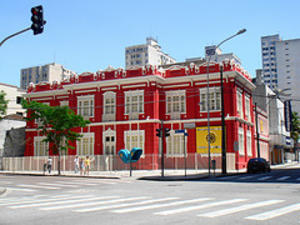 Museu de Arte Contemporânea do Paraná - MAP 7 Currently the Museum has about 1500 names of the most representative works of visual arts in the country, including painting, drawing, printmaking, sculpture, photography, object, tapestry, collage, installation and video. Among the artists represented in the collection, there are Tomás Abal, Lothar Charoux, Volpi, Amilcar de Castro, Regina Silveira, José Bechara, Antonio Peticov, José Rufino, Alex Flemming, &Eacut... Museu de Arte Contemporânea do Paraná - MAP 7 Currently the Museum has about 1500 names of the most representative works of visual arts in the country, including painting, drawing, printmaking, sculpture, photography, object, tapestry, collage, installation and video. Among the artists represented in the collection, there are Tomás Abal, Lothar Charoux, Volpi, Amilcar de Castro, Regina Silveira, José Bechara, Antonio Peticov, José Rufino, Alex Flemming, &Eacut... |
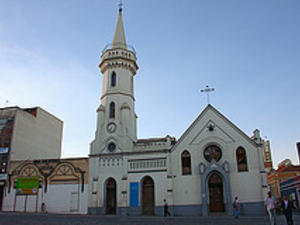 Museu de Arte Sacra de Curitiba - MAP 7 The Sacred Art Museum of the Archdiocese of Curitiba - Masac has in its collection over 800 pieces classified as objects of worship, liturgical vestments, rare books, furniture, photographs, paintings, pictures and personal belongings. Among the pieces, there is the image of Good Jesus of the Pines, in terracotta, of the late seventeenth century. Besides the permanent exhibition of the collection, temporary exhibitions are organized wit... Museu de Arte Sacra de Curitiba - MAP 7 The Sacred Art Museum of the Archdiocese of Curitiba - Masac has in its collection over 800 pieces classified as objects of worship, liturgical vestments, rare books, furniture, photographs, paintings, pictures and personal belongings. Among the pieces, there is the image of Good Jesus of the Pines, in terracotta, of the late seventeenth century. Besides the permanent exhibition of the collection, temporary exhibitions are organized wit... |
| Museum of Natural History - MAP 3 This museum is contains roughly 36,000 square meters of exposition, including animal taxidermy and dehydrated vegetables. The Museum of Natural History is setup to teach about animals and plants and about how they live together and rely upon each other. Outside the Museum of Natural History there is an outdoor path that leads through an Araucaria tree forrest called the “Caminho das Araucárias” and w... |
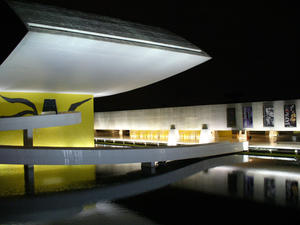 Oscar Niemeyer Museum - MAP 7 The Oscar Niemeyer Museum is one of the largest exhibition complexes in Brazil, with approximately 16,000 square meters in the display of artwork. The museum also includes an auditorium capable of seating 400, a café and several areas for resting tired feet. A wonderful tourist attraction that visitors from around the country come to see. Opened in November 2002 under the name of the "New Museum", it was de... Oscar Niemeyer Museum - MAP 7 The Oscar Niemeyer Museum is one of the largest exhibition complexes in Brazil, with approximately 16,000 square meters in the display of artwork. The museum also includes an auditorium capable of seating 400, a café and several areas for resting tired feet. A wonderful tourist attraction that visitors from around the country come to see. Opened in November 2002 under the name of the "New Museum", it was de... |
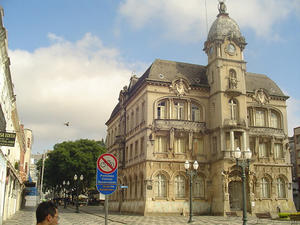 Paranaense Museum - MAP 7 Founded in 1876, the Museum of Paraná was the first museum of the state of Paraná and the third in Brazil. The Paranaense Museum collection contains over 300 000 artefacts and old colonial documents. Artefacts include pieces of Indian origin from all over Brazil, including archaeological findings, maps of colonial Brazil, and works of art.
In July 2003, the Paranaense Museum took the place of the old Art M... Paranaense Museum - MAP 7 Founded in 1876, the Museum of Paraná was the first museum of the state of Paraná and the third in Brazil. The Paranaense Museum collection contains over 300 000 artefacts and old colonial documents. Artefacts include pieces of Indian origin from all over Brazil, including archaeological findings, maps of colonial Brazil, and works of art.
In July 2003, the Paranaense Museum took the place of the old Art M... |
| Photography Museum of the City of Curitiba - MAP 7 The Museum of Photography maintains an annual schedule of exhibitions with works from the collection, in addition to housing exhibitions of Brazilian and foreign photographers. Headquarters of major international events, the Museum has received memorable exhibits from around the world and also offers its collections for participation in national and international photography through partnership with the world main institutions, oc... |
 Expedicionario Museum - MAP 7 The Museu do Expedicionário constitutes today one of the most complete thematic museums in Brazil regarding the second world war, having in its collection a large quantity of documents, photographs, maps and illustrations.
In it are exposed to various kinds of war materials, such as uniforms, equipment, individual and collective, weapons, ammunition, and other objects that were used by the Brazilian Expeditionary Force (...
Expedicionario Museum - MAP 7 The Museu do Expedicionário constitutes today one of the most complete thematic museums in Brazil regarding the second world war, having in its collection a large quantity of documents, photographs, maps and illustrations.
In it are exposed to various kinds of war materials, such as uniforms, equipment, individual and collective, weapons, ammunition, and other objects that were used by the Brazilian Expeditionary Force (... Ferroviário Museum - MAP 7 The Railroad Museum of Curitiba is situated in Curitiba's former train station, on the Avenida Sete de Setembro. Much of the old station has been fully restored, allowing visitors to actually see what the old rail road era was like and how it functioned. There are many displays, including numerous bells, rail road documents, historic and typical furnishings, original maps, old telephones and original train whistles. There are also ple...
Ferroviário Museum - MAP 7 The Railroad Museum of Curitiba is situated in Curitiba's former train station, on the Avenida Sete de Setembro. Much of the old station has been fully restored, allowing visitors to actually see what the old rail road era was like and how it functioned. There are many displays, including numerous bells, rail road documents, historic and typical furnishings, original maps, old telephones and original train whistles. There are also ple... Museu Botânico de Curitiba - MAP 7 The Botanical Museum Hall in the Botanical Garden of Curitiba, has ample space for exhibitions, a library and auditorium. It has an herbarium of 310,000 plants, known worldwide, with the largest number of genera and families of plants in Brazil. It was created in 1965 from the donation of the personal collection of botanical researcher Gerdt Hatschbach. His first headquarters were on the Public Road. Only in 1992 the Museum was transfe...
Museu Botânico de Curitiba - MAP 7 The Botanical Museum Hall in the Botanical Garden of Curitiba, has ample space for exhibitions, a library and auditorium. It has an herbarium of 310,000 plants, known worldwide, with the largest number of genera and families of plants in Brazil. It was created in 1965 from the donation of the personal collection of botanical researcher Gerdt Hatschbach. His first headquarters were on the Public Road. Only in 1992 the Museum was transfe... Museu de Arqueologia e Etnologia - MAP 7
The Museum of Archaeology and Ethnology at UFPR (MAE), was inaugurated in 1962 and is the first university museum in the state of Parana. The main office is located in the municipality of Paranaguá, in the premises of the building that housed the former Jesuit College, founded in 1755. The headquarters building of the museum was transferred to the custody of UFPR in 1958. In addition to this seat in Paranagua, it has its Techn...
Museu de Arqueologia e Etnologia - MAP 7
The Museum of Archaeology and Ethnology at UFPR (MAE), was inaugurated in 1962 and is the first university museum in the state of Parana. The main office is located in the municipality of Paranaguá, in the premises of the building that housed the former Jesuit College, founded in 1755. The headquarters building of the museum was transferred to the custody of UFPR in 1958. In addition to this seat in Paranagua, it has its Techn... Museu de Arte Contemporânea do Paraná - MAP 7 Currently the Museum has about 1500 names of the most representative works of visual arts in the country, including painting, drawing, printmaking, sculpture, photography, object, tapestry, collage, installation and video. Among the artists represented in the collection, there are Tomás Abal, Lothar Charoux, Volpi, Amilcar de Castro, Regina Silveira, José Bechara, Antonio Peticov, José Rufino, Alex Flemming, &Eacut...
Museu de Arte Contemporânea do Paraná - MAP 7 Currently the Museum has about 1500 names of the most representative works of visual arts in the country, including painting, drawing, printmaking, sculpture, photography, object, tapestry, collage, installation and video. Among the artists represented in the collection, there are Tomás Abal, Lothar Charoux, Volpi, Amilcar de Castro, Regina Silveira, José Bechara, Antonio Peticov, José Rufino, Alex Flemming, &Eacut... Museu de Arte Sacra de Curitiba - MAP 7 The Sacred Art Museum of the Archdiocese of Curitiba - Masac has in its collection over 800 pieces classified as objects of worship, liturgical vestments, rare books, furniture, photographs, paintings, pictures and personal belongings. Among the pieces, there is the image of Good Jesus of the Pines, in terracotta, of the late seventeenth century. Besides the permanent exhibition of the collection, temporary exhibitions are organized wit...
Museu de Arte Sacra de Curitiba - MAP 7 The Sacred Art Museum of the Archdiocese of Curitiba - Masac has in its collection over 800 pieces classified as objects of worship, liturgical vestments, rare books, furniture, photographs, paintings, pictures and personal belongings. Among the pieces, there is the image of Good Jesus of the Pines, in terracotta, of the late seventeenth century. Besides the permanent exhibition of the collection, temporary exhibitions are organized wit... Oscar Niemeyer Museum - MAP 7 The Oscar Niemeyer Museum is one of the largest exhibition complexes in Brazil, with approximately 16,000 square meters in the display of artwork. The museum also includes an auditorium capable of seating 400, a café and several areas for resting tired feet. A wonderful tourist attraction that visitors from around the country come to see. Opened in November 2002 under the name of the "New Museum", it was de...
Oscar Niemeyer Museum - MAP 7 The Oscar Niemeyer Museum is one of the largest exhibition complexes in Brazil, with approximately 16,000 square meters in the display of artwork. The museum also includes an auditorium capable of seating 400, a café and several areas for resting tired feet. A wonderful tourist attraction that visitors from around the country come to see. Opened in November 2002 under the name of the "New Museum", it was de... Paranaense Museum - MAP 7 Founded in 1876, the Museum of Paraná was the first museum of the state of Paraná and the third in Brazil. The Paranaense Museum collection contains over 300 000 artefacts and old colonial documents. Artefacts include pieces of Indian origin from all over Brazil, including archaeological findings, maps of colonial Brazil, and works of art.
In July 2003, the Paranaense Museum took the place of the old Art M...
Paranaense Museum - MAP 7 Founded in 1876, the Museum of Paraná was the first museum of the state of Paraná and the third in Brazil. The Paranaense Museum collection contains over 300 000 artefacts and old colonial documents. Artefacts include pieces of Indian origin from all over Brazil, including archaeological findings, maps of colonial Brazil, and works of art.
In July 2003, the Paranaense Museum took the place of the old Art M...